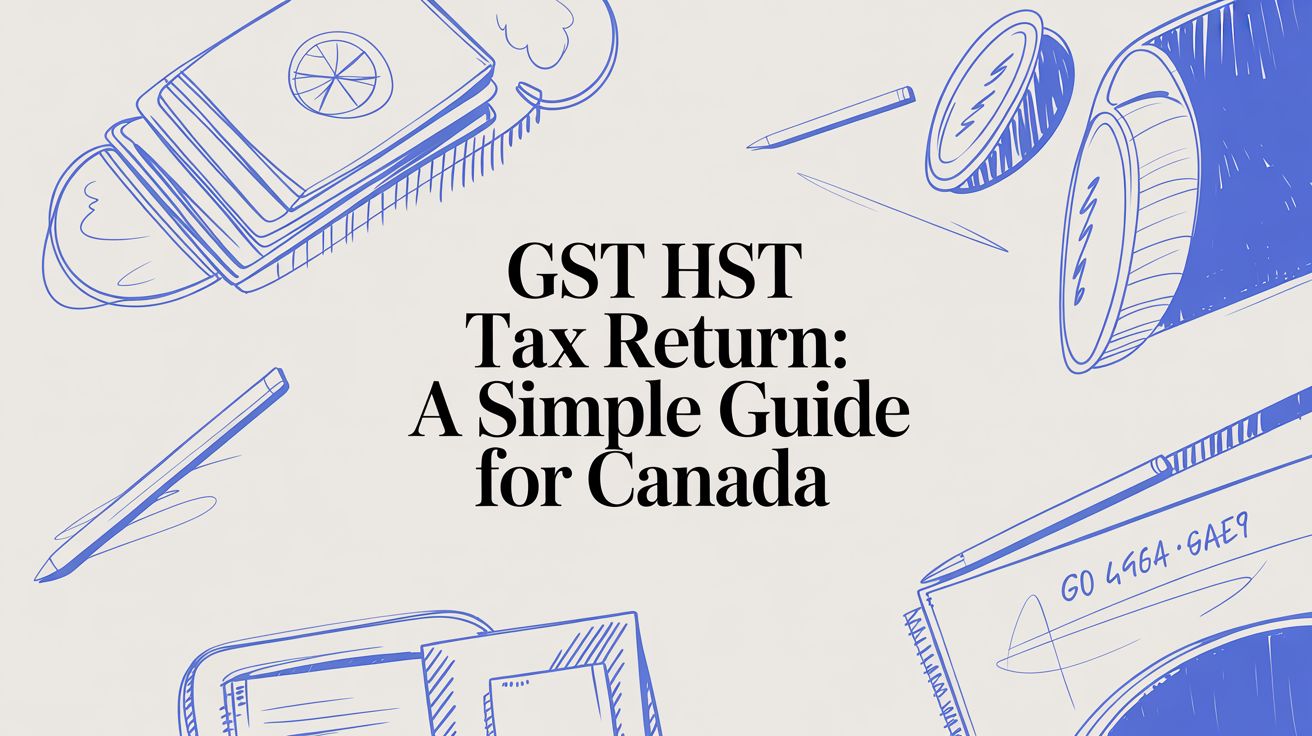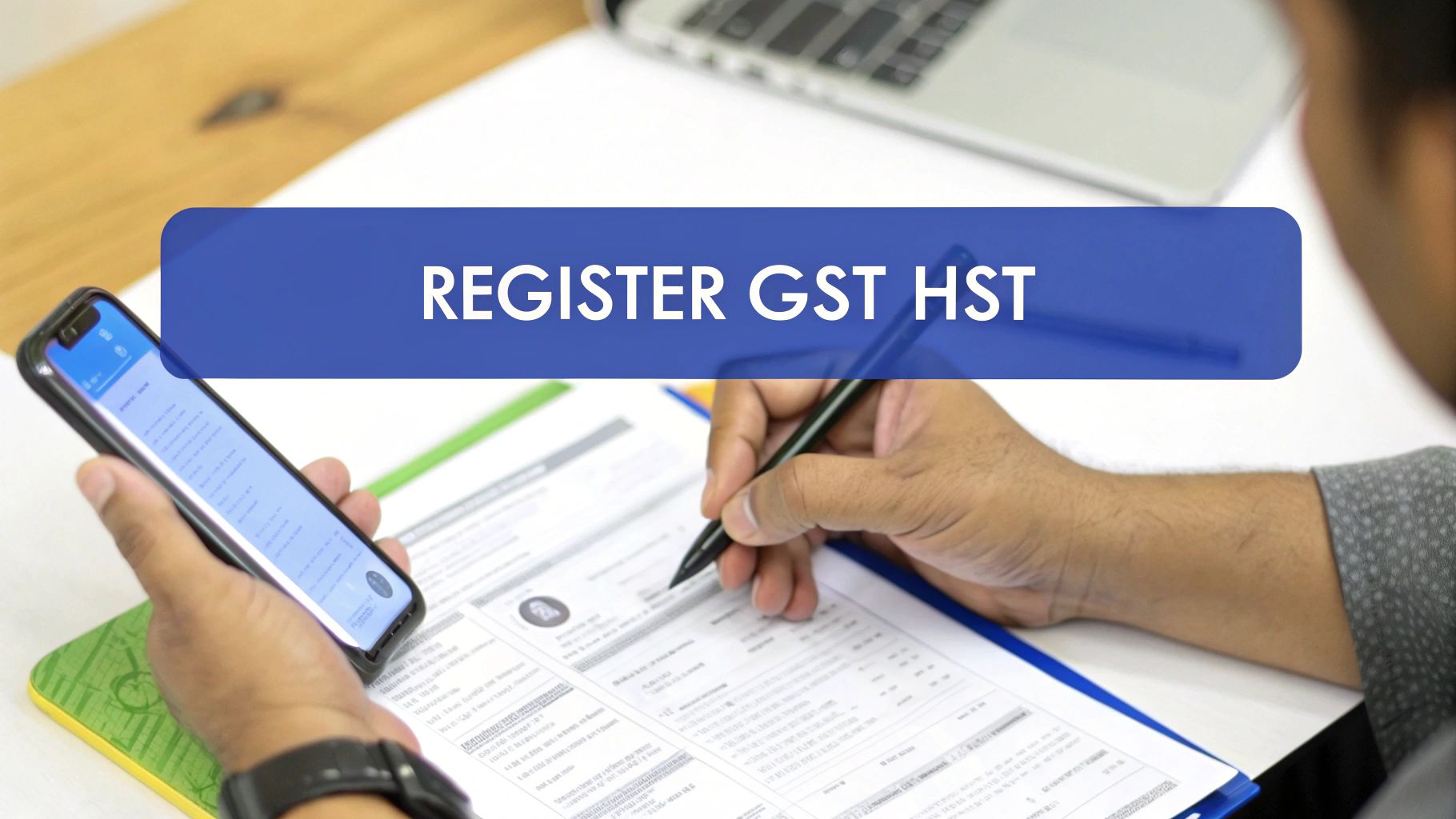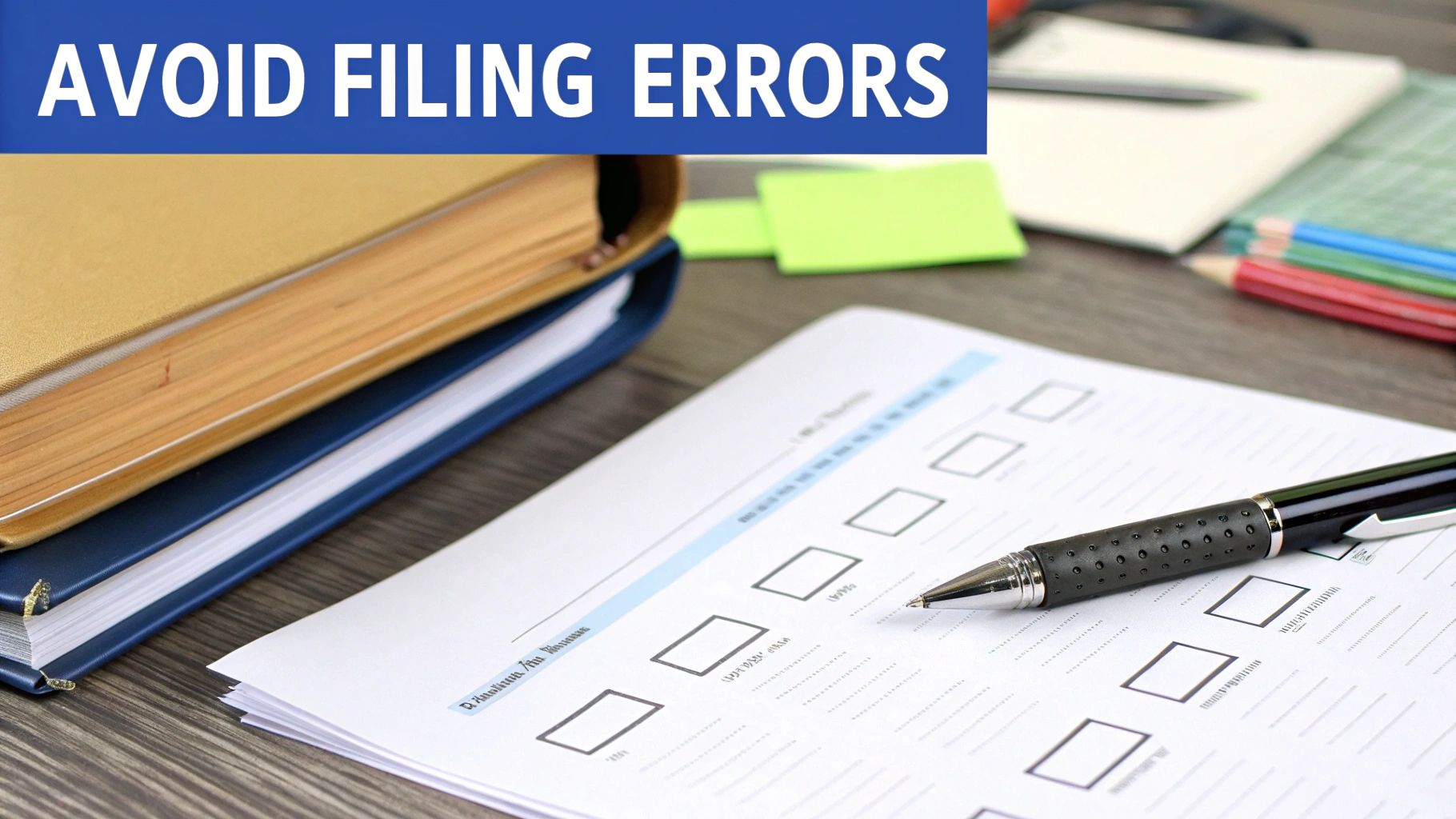

Filing your first GST HST tax return is a major milestone for any newly incorporated Canadian business. It's how you'll report the Goods and Services Tax (GST) or Harmonized Sales Tax (HST) you’ve collected from your customers, and just as importantly, how you'll claim back the GST/HST you've paid on your own business expenses.

Once your business is officially incorporated, getting your tax situation sorted is priority number one. The GST/HST is a value-added tax that applies to most goods and services sold across Canada. For your new corporation, this means you'll need to charge it, collect it, and then send it off to the Canada Revenue Agency (CRA).
It can sound a little intimidating at first, but it’s a standard part of operating in Canada. You're joining about two million other GST/HST registrants, the majority of whom are small businesses just like yours. This tax touches nearly every industry, from retail shops to construction companies, which shows just how fundamental it is to the Canadian economy. If you're curious about the numbers, the government provides official GST/HST statistics.
Before you can tackle your GST HST tax return, you need to get comfortable with the language. Here are the three core concepts you’ll see again and again:
Depending on where you do business in Canada, you'll be dealing with either GST or HST. They function similarly but apply in different provinces.
Here’s a quick overview of how the two taxes compare:
Essentially, HST just simplifies things for businesses in participating provinces by combining the federal and provincial taxes into one. In other provinces, you may need to manage the 5% GST and a separate Provincial Sales Tax (PST) if applicable.
Not every startup needs to register for a GST/HST account right out of the gate. The magic number to watch for is the $30,000 small supplier threshold. If your company's worldwide taxable revenues top that amount over any four consecutive calendar quarters, you are required to register.
That said, many businesses decide to register voluntarily long before they hit the $30,000 mark. Why? Because registering allows you to start claiming ITCs immediately, which can be great for your cash flow. It’s a strategic move worth considering early on. Getting registered correctly is a crucial first step—for a full walkthrough, check out our guide on how to register a company.
Setting up your business properly from the start, especially tax registrations, paves the way for smooth sailing later. Government portals for these tasks can be slow, confusing, and filled with potential pitfalls for new entrepreneurs.
This is where Start Right Now comes in. We take the headache out of the entire process, helping you incorporate and get all your tax accounts set up correctly from day one. Our platform automates these critical steps, so you can move from idea to fully compliant corporation without the administrative drag.

Before you can even think about filing your first GST/HST tax return, you need to get your corporation an official GST/HST account with the Canada Revenue Agency (CRA). This is the critical step that connects your business to the federal tax system. The account itself is attached to your Business Number (BN), which is your company's unique ID for all things government-related.
So, when does registration become a must-do? The magic number is $30,000. If your worldwide revenue from taxable goods and services climbs past this amount in any four consecutive calendar quarters, you've crossed the small supplier threshold. At that point, the law requires you to register, start collecting the tax, and file returns.
You don't have to wait until you hit that $30,000 mark. In fact, many new corporations get registered voluntarily right from the start, and for good reason. It’s a smart strategic move that allows you to immediately begin claiming Input Tax Credits (ITCs) on your business expenses.
Think about all the initial costs of launching. You're buying equipment, signing up for software subscriptions, and maybe paying for legal or accounting advice. By registering for GST/HST right away, you can get back the tax you paid on all those purchases. This can be a huge help for your cash flow when you're just getting off the ground.
Registering for a GST/HST account is essential, but let's be honest—dealing directly with government portals can be a frustrating and time-sucking task for any entrepreneur. One small mistake can create big compliance headaches later on.
This is exactly why bundling your GST/HST registration with your incorporation service is the smartest, most efficient way to go.
Instead of getting bogged down in complicated government forms, you can handle everything in one simple, streamlined process. When you incorporate with Start Right Now, we do more than just register your business name and legal structure. We also set up your crucial CRA program accounts for you, including your GST/HST account.
This all-in-one approach guarantees that your business is set up correctly from day one.
Handling your incorporation and tax registrations together just gives you peace of mind. To learn more about the number that underpins all these accounts, check out our guide on how to get a business number in Canada. By using Start Right Now, you can be confident your new corporation is fully compliant and ready to operate from the moment you launch.

Alright, this is where you get down to the numbers on your GST HST tax return. The whole point of the filing process is to figure out your net tax—the final amount you either have to pay the Canada Revenue Agency (CRA) or will get back as a refund.
The core idea is simple. You take the total GST/HST you charged and collected from your customers, and from that, you subtract the GST/HST you paid on your business expenses. These expenses are called Input Tax Credits (ITCs).
What’s left over is what you owe the government.
Think of it like a ledger with two sides.
On one side, you have the tax you’ve collected. As a GST/HST registrant, it’s your job to add the correct tax rate to all your taxable sales. That money isn't really yours; you’re just holding onto it for the government until your filing deadline.
On the other side, you have your ITCs. This is where you get to claim back the GST/HST you paid on legitimate business purchases. It's essentially the CRA giving you a credit for the tax you spent just to run your company. Most of your day-to-day business costs will have ITCs you can claim, including:
Getting a firm grip on the difference between the tax you collect and the ITCs you can claim is the single most important part of managing your GST/HST obligations. It keeps your books accurate and your cash flow in check.
Let's walk through a quick, practical scenario. Say you run a new consulting business in Ontario, where the HST is 13%.
During your first quarterly reporting period, you invoiced your clients for a total of $15,000. On top of that, you collected $1,950 in HST ($15,000 x 13%). This is the amount you're holding for the CRA.
Over those same three months, you had some startup costs:
Your total claimable ITCs are the sum of the HST you paid on these expenses, which comes to $364 ($260 + $65 + $39).
Now for the final calculation:
$1,950 (HST Collected) - $364 (ITCs Claimed) = $1,586 (Net Tax Owed)
So, when you file your GST HST tax return, you’ll need to send a payment of $1,586 to the CRA.
It’s worth noting that if your ITCs were more than the tax you collected—which often happens when a business first starts and has a lot of initial expenses—the CRA would actually owe you a refund.
Once you've registered for your GST/HST account, the Canada Revenue Agency (CRA) will assign you a reporting period. This isn't just an arbitrary date—it dictates how often you have to file your GST/HST tax return, and it's based entirely on your annual revenue from taxable sales.
For most new businesses just starting out, you'll likely be put on an annual filing schedule. But as your business grows, the CRA expects you to check in more often. Knowing where these lines are drawn is key to staying on the right side of the CRA and avoiding late filing penalties.
The CRA uses specific revenue thresholds to set your filing frequency. It’s pretty straightforward once you see the breakdown:
Now, while the CRA assigns you a period, you aren't always locked in. For instance, if you're an annual filer but you consistently pay more GST/HST on your expenses than you collect from customers, you might want to switch to quarterly filing. Why? It means you can get your refund from the government faster instead of waiting until the end of the year.
The form you'll get to know is the GST34, officially called the GST/HST Return for Registrants. The process involves reporting key figures on specific lines.
The two most important lines you’ll focus on are Line 105 (where you report the total GST/HST you collected) and Line 108 (where you claim all your Input Tax Credits). The difference between these two is your net tax—either what you owe the CRA or what they owe you. It sounds simple, but getting those numbers right means you need to have kept pristine records all year.
This is a totally separate beast from your corporate filings. If you want a refresher on that, check out our guide to filing your annual return for your corporation.
One of the biggest hurdles for any new business owner is just keeping all the government deadlines straight. A missed GST/HST deadline isn't just a slap on the wrist; it triggers immediate penalties and interest that compounds daily.
This is exactly why having a single, organized system is so crucial. Instead of trying to remember logins and dates for multiple government websites, a platform like Start Right Now gives you a clear, simple dashboard for all your compliance tasks. We designed it to take the headache out of these administrative chores so you can stay compliant without the stress.
Once your GST/HST return is filed and you know what you owe, the last piece of the puzzle is sending that payment to the Canada Revenue Agency (CRA). This isn't just a box-ticking exercise; it's a crucial part of keeping your new company financially healthy.
The CRA gives you a few different ways to settle your balance. For many business owners, the easiest route is through online banking, just like paying any other bill. You simply add the CRA as a payee and send the funds. Another popular option is the CRA's own "My Payment" service, which lets you pay directly from your bank account.
Let me be blunt: your payment deadline is non-negotiable. The second you miss it, the CRA starts charging compound daily interest on the amount you owe. It’s a financial snowball that can quickly get out of hand, draining cash flow you’d much rather invest back into your business.
Paying on time means you completely sidestep these extra costs. And on the bright side, if the CRA owes you a refund, they’re usually pretty quick to pay up, typically within a few weeks. Setting up direct deposit is the fastest way to get your money back.
Think of it this way: late payment interest is one of the most avoidable expenses in business. It’s a direct penalty for missing a date on the calendar. Getting this right from the start sets a strong foundation for financial discipline.
The interest the CRA charges isn't just a slap on the wrist. The rates are updated every quarter and are designed to sting. For example, the rate for overdue taxes is often significantly higher than the rate the CRA pays on refunds it owes to businesses.
To give you an idea, the rate on taxpayer arrears for early 2025 was double the rate paid on corporate refunds. This gap isn't an accident; it's a clear signal from the government that they expect you to pay on time. You can always check the most current figures on the CRA's interest rates page.
Keeping your CRA account clean is much easier when your business is set up properly from day one. When you incorporate with Start Right Now, we make sure your business and tax accounts are established correctly from the get-go. Our goal is to give you the clarity and tools to manage your obligations, helping you avoid the stress of penalties and interest charges that can trip up new entrepreneurs.

Let's be honest, handling your first few GST HST tax return filings can be a nerve-wracking experience. It's easy to make a simple mistake that can unfortunately lead to penalties, a dreaded audit notice from the Canada Revenue Agency (CRA), or even just missing out on a refund you're entitled to.
Knowing what these common tripwires are from the get-go is your best defence. It helps you sidestep the headaches and keep your relationship with the CRA smooth and stress-free.
One of the most common stumbles is simply missing the filing deadline. Business owners are juggling a million things, but the CRA's deadlines don't budge. Filing late means an instant penalty, and then compound daily interest starts piling up on any amount owing. That can eat into your profits faster than you'd think.
Another classic error is claiming Input Tax Credits (ITCs) for things you can't. You might assume any business purchase is fair game, but some expenses—like certain financial services or items that are really for personal use—are restricted. If the CRA flags an improper claim down the line, they'll disallow it and send you a bill for the difference, plus interest.
At the heart of most filing headaches is disorganized bookkeeping. It's the root of all evil when it comes to taxes. If you don't have a clean, accurate log of your sales and expenses, figuring out your net tax becomes a nightmare of guesswork.
Messy records often mean you under-claim your ITCs—literally leaving your own money on the table. Even worse, you could misreport the GST/HST you collected, which is a sure-fire way to get unwanted attention from the CRA.
A solid business foundation is your best defence against common tax filing mistakes. Getting your incorporation and initial tax registrations handled correctly from the very beginning sets a precedent for strong financial habits and minimizes administrative risks down the road.
This is exactly why having a service like Start Right Now is so valuable. Instead of trying to navigate complex government websites and risking a misstep, we handle your incorporation and CRA account setup in one go. Our platform is built to give you a clean, compliant start so you can focus on what you do best—building your business—with the peace of mind that the administrative side is handled.
Getting organized is the first step. The next is being aware of the specific traps new business owners often fall into.
Here’s a quick summary of the most frequent errors we see and, more importantly, how to sidestep them.
GST/HST Filing Common Mistakes and Solutions
By keeping these points in mind, you can build solid habits from day one. Good bookkeeping isn't just about compliance; it's about running a smarter, more profitable business and keeping your GST HST tax return process as painless as possible.
When you're launching a new business, the tax side of things can feel like a maze. Let’s clear up some of the most common questions new entrepreneurs have about filing their GST/HST tax return.
It's easy to get these acronyms mixed up. Think of it like this:
Yes, you usually can! This is a great tip that many new business owners miss. You're generally allowed to claim Input Tax Credits (ITCs) for the GST/HST you paid on business-related expenses even before your official registration date.
This applies to things like initial inventory, equipment, and other startup costs. The key is that these expenses must directly relate to your commercial activities. This is why holding onto every single receipt from the moment you decide to start your business is so important.
Did you know? The GST/HST system also provides a personal benefit. The federal GST/HST credit helps low- and modest-income individuals and families. In the 2023-2024 benefit year, about 10 million Canadians received these payments. The CRA automatically determines eligibility based on your personal tax return. You can see more GST/HST credit statistics on the Government of Canada's website.
This is a scenario you want to avoid at all costs. If you were legally required to be registered and you didn't collect GST/HST on your sales, the Canada Revenue Agency (CRA) will still expect you to pay it.
Essentially, the CRA considers that tax payable whether you collected it or not. That means you’ll have to remit the amount you should have collected out of your own pocket. On top of that, you could be facing some hefty penalties and interest charges. It’s a painful and expensive lesson in the importance of registering on time.
Getting your incorporation and tax accounts set up properly from day one is the single best way to sidestep these kinds of headaches. Start Right Now makes the entire setup painless, managing your incorporation and CRA registrations so you can focus on building your business, not on paperwork. You can get started in just a few minutes at https://www.startrightnow.co.